| |
Keane
of Kilnamona
Pat Keane
of
Ballymongaun, Kilnamona
Summary
 Born on April 6 1894, Pat Keane was the
third child of Johnny (Matthew) Keane (second
child by his second wife) (see parents).
From an early age he joined the Irish Volunteers - Óglaigh na
hÉireann - in the struggle for
the freedom of Ireland in which he took a leading role.
Intending to take up a military career on the formation of the new
state when independence was achieved, and although originally
expected to take over the home farm at Ballyashea, Pat relinquished
title and invited his brother Andrew to return home from the U.S.A.
Later, he took the republican side in the Civil War that followed
independence and declined to join the army of the newly formed
State. Pat received the Gold
Fáinne
while interred for post-treaty republican activities in the
Gormanstown camp which entitled him to teach Irish to adults at
night school. This he did subsequently in Kilnamona, Dysart
and Toonagh.
Pat married Bridget O'Dea, Ahasla, Kilnamona "whom he had been
courting for years" (Br
Thomas memoirs, 1987) marrying into her small farm in June 1925
(see marriage photograph). Bridget had studied dressmaking in
Ennis for four years (see
O'Dea) and a small income
from same helped to supplement the family resources. All were
excellent workers and applied themselves to extreme to their work as
conditions were extremely tough. Born on April 6 1894, Pat Keane was the
third child of Johnny (Matthew) Keane (second
child by his second wife) (see parents).
From an early age he joined the Irish Volunteers - Óglaigh na
hÉireann - in the struggle for
the freedom of Ireland in which he took a leading role.
Intending to take up a military career on the formation of the new
state when independence was achieved, and although originally
expected to take over the home farm at Ballyashea, Pat relinquished
title and invited his brother Andrew to return home from the U.S.A.
Later, he took the republican side in the Civil War that followed
independence and declined to join the army of the newly formed
State. Pat received the Gold
Fáinne
while interred for post-treaty republican activities in the
Gormanstown camp which entitled him to teach Irish to adults at
night school. This he did subsequently in Kilnamona, Dysart
and Toonagh.
Pat married Bridget O'Dea, Ahasla, Kilnamona "whom he had been
courting for years" (Br
Thomas memoirs, 1987) marrying into her small farm in June 1925
(see marriage photograph). Bridget had studied dressmaking in
Ennis for four years (see
O'Dea) and a small income
from same helped to supplement the family resources. All were
excellent workers and applied themselves to extreme to their work as
conditions were extremely tough.
-
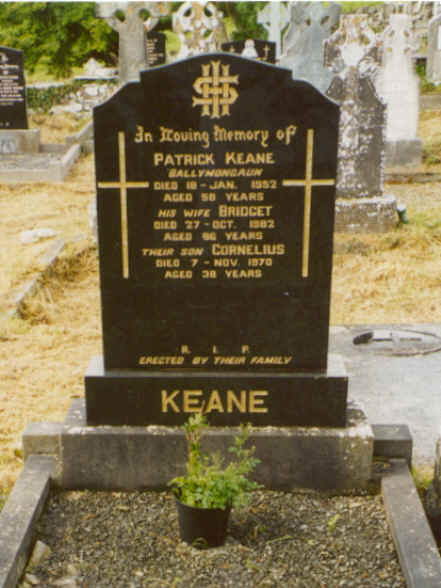 Pat
and Bridget
had ten in family, two girls followed by eight boys but the second
last child died at birth (thus leaving a family of nine). Six
of the family were born in Ahasla, the remaining four at
Ballymongaun, where Pat had acquired a number of small farm holdings . In 1934 Pat "took his courage in his hands" and
completed a new two-storied house at
Ballymongaun,
almost entirely on his own, being very gifted at that type of work
"so that his children would be near secondary education in
Ennis" (Br Thomas). He was also of a very academic nature,
being well noted for his literary abilities. Pat died on 18th
January 1952, at 57 years and Bridget (see
O'Dea) survived him by
thirty years, being 86 years when she died on 27 October 1982.
Both are buried in the family plot in the old graveyard, Kilnamona
(RIP).
(more on
Pat's farm). Pat
and Bridget
had ten in family, two girls followed by eight boys but the second
last child died at birth (thus leaving a family of nine). Six
of the family were born in Ahasla, the remaining four at
Ballymongaun, where Pat had acquired a number of small farm holdings . In 1934 Pat "took his courage in his hands" and
completed a new two-storied house at
Ballymongaun,
almost entirely on his own, being very gifted at that type of work
"so that his children would be near secondary education in
Ennis" (Br Thomas). He was also of a very academic nature,
being well noted for his literary abilities. Pat died on 18th
January 1952, at 57 years and Bridget (see
O'Dea) survived him by
thirty years, being 86 years when she died on 27 October 1982.
Both are buried in the family plot in the old graveyard, Kilnamona
(RIP).
(more on
Pat's farm).
Making a Stand... Military Career.... Anti
Treaty Activities.... Internment Camp.... Academic Side of Pat....
Lighter Side of Life in the Volunteers.... Supervisor with
Department of Agriculture.... The Penultimate Years.... Reader of
News and Historic Events.... Life's Review....Rambling House
Story.... War of Independence and Civil War: Pat's Testimonial
Statement.... Truce Period.... Appreciation (Clare Champion).
Pat (Patrick)
Keane: 1894 - 1952
Ballyashea/Ballymongaun, Kilnamona
Revolutionary and Nationalist!
Making a Stand
Pat's public life might said to start with
his attendance at the inaugural meeting of the (original) Sinn Féin
organization in County Clare held at O'Callaghan Mills in 1915. It
seems only some dozen delegates from the county were in attendance,
including 'Fagan' McNamara, Crusheen - both he and Pat represented
the same extensive division of (mid) Clare (information kindly
provided by Sean McNamara, son of Fagan;
also see
for instance reference to Clare Battalion
Division (2) Crusheen,
Inch, Ennis and District – S. Mac Conmara in charge).
Following this the Clare Sinn Féin organization blossomed with its
first political success in the parliamentary bye election in East
Clare of 1917 and general election of 1918. Pat was already a member
of the Irish Volunteers (Óglaigh na hÉireann) which existed in most parishes before
the summer of 1913 (see Witness Statement, WS 1324, by Joe Barrett
in the National Archives, Dublin). Due to confusing orders from
Dublin, Pat was not called upon to fight in the 1916 Easter rising,
but was ready, 'attended meetings and standing to' (see Testimonial
Statement below).
The First World War was entering its final
phase and the British offensive in Europe was underway in 1917
(probably 1918!) when Pat 'received notice' to join the
British army. Pat's mother was very upset one day because a
peeler (police officer) had called to the home giving advance notice
that her son Pat would be conscripted. Owing to concerted
opposition from Church and Sinn Féin (De Valera), conscription of
the Irish never took place (Br
Thomas remembers).
Clare was declared a Special Military Area
in February 1918 due to agrarian disorder. In the spring of 1918,
several men with their horses and ploughs could be seen tilling the
land of the Landlord Crowe at Ballymongaun, Kilnamona. They
were asserting the right of the Irish people to own their land.
Next morning four men from the parish were arrested. Two
participants (Mick Brody and Pat Keane) refusing to recognise the
court were sentenced to three months in Mountjoy Jail (Mick Guerin
and Tom O'Brien were released on promise of good behaviour).
Br Thomas (1987) recalls that 'the rumour at the time (was) that the
men in Mountjoy were going to be sent to the front but it didn't
happen.' Later, Sinn Fein discouraged further agrarian action
especially cattle rustling, 'in order not to distract from the war
effort and took up the campaign against conscription' (e.g. The War
in Clare 1911-1921, Michael Brennan, Four Courts Press, 1980). Clare
was divided into three brigade areas in December 1918 (Brennan)
while David Fitzpatrick (see ref. later) states that Mid-Clare
Brigade was established on March 1st 1919!
Military Career
Pat Keane was
attached to the Mid-Clare Brigade of the Volunteers and in turn was
Kilnamona Coy (Company) Section Commander (1919), Adjutant (1920)
and Officer in Command (1921) with over 60 men under his charge (cf
Pat's Application for a Service Certificate in Dept of Defence,
1935). While in the latter posting Pat was also a member of the
A.S.U. (Active Service Unit), 3rd Battalion, Mid-Clare Company, IRA
operating all over the Mid Clare Brigade area.
Some of the more important engagements in
which Pat took part included the disarming of seven soldiers who
daily paraded through the streets of Ennis on the evening of June
23rd, 1920; the capture of guns from the Barracks in the
neighbouring parish of Ruan in October 1920, under Joe Barrett,
Adjutant, Mid-Clare Brigade (see WS 1324 and WS 1326, National
Archives (NA), and Andrew O'Donoghue (AO'D)
report 1 on web), and the highly dangerous transport of a
consignment of guns from Ennis for the Monreel ambush near Miltown
Malbay, December 18th, 1920 (WS1326; AO'D
report 2), and a number of ambushes which were abandoned due the
enemy not appearing.
The Ennis assault is interesting in that
volunteers were specially selected for a task which required
considerable co-ordination - any failure on the part of any of the volunteers could have had disastrous consequences for all.
Intensive rehearsals were held over the previous 12 nights 'using a
party of twenty one men with seven set aside representing the
soldiers until each (was) thoroughly proficient in his particular
duty' (WS 1324, also see
Bureau of Military History or
here). A signal whistle blast was given (WS 1135)
and 'each member of the guard was attacked individually and
simultaneously, so complete surprise, and overpowered at once... it
lasted about two minutes' (WS, 1324; W.S. 1261). Success was achieved
without loss of life on either side.
Scrutinising
closely Pat's own testimony (reproduced below) he states that
'on the 23rd June 1920, I was
posted with gun at O’Connell St Ennis to hold up
a
British soldier with rifle and bayonet on the occasion of the
successful
disarming of the British Patrol'. From the Witness Statements of the 1950s
further details can be gleamed. According to Seán 'Keeffe (W.S.
1261, pp 14-19) the plan of attack was for the splitting up of the men into
groups of three, each group of three were to
overpower and disarm a designated soldier.
O'Keeffe listed Pat as one such member (of the total 21 listed)
assigned to a disarming group (others from Kilnamona Coy. were
Michael Hegarty, Patrick Brody and Joseph Barrett).
For the capture of the Ruan Barrack, Joe Barrett states that 'men,
picked for coolness, dash and courage, and drawn from all areas of
the Brigade area, were set aside for the immediate work of storming
the barracks' (WS 1324, National Archives). Br Thomas in his
memoirs writes: "He (Pat) took part in some way in the disarming of
soldiers in Ennis and he also took some part in the taking of Ruan
barracks." Br. Thomas
also remembers that Pat "was accused whether guilty or not of
breaking peelers bicycles and throwing them into the stream that
runs (near Kilnamona church) between Hegartys and Galvins", and that
he "brought the rifles from the Monreal ambush from Kilnamona to
Cloonagh, hidden under hay." For Pat's own account of his role in
these engagements, see his Testimonial Statement appended below.
Pat's seems not to have been one of the
50-60 men (they were mostly from the 5th Batt, however) of the newly
formed (November 1920) Battalion Flying Column under Joe Barrett
although he was usually 'on the run' from the authorities.
Apparently his O.C. responsibilities seems to have precluded this,
e.g. he was also responsible for the security of the many Brigade
Council meeting held in his area, e.g. that recounted in WS 1326
(AO'D
report 3) of a meeting held in Patsie Hegarty's house,
Kilnamona, early in May 1921 where a representative of GHQ Dublin sought
increased harassment of crown forces by Mid-Clare Brigade (to take
the heat off Cork!).
 Over:-
Mid-Clare Unit IRA activists, circa. 1921. Back row from left: Pakie
Kerin, Darragh; Pat Keane, Kilnamona; unknown; Centre row: Jack
Irwin!! (see Feedback,
msg 40!), unknown; Front row: Vincent Barrett (in uniform); Thomas
Callaghan*,Cloonanaha (with gun); Patrick McGough, Inagh. Over:-
Mid-Clare Unit IRA activists, circa. 1921. Back row from left: Pakie
Kerin, Darragh; Pat Keane, Kilnamona; unknown; Centre row: Jack
Irwin!! (see Feedback,
msg 40!), unknown; Front row: Vincent Barrett (in uniform); Thomas
Callaghan*,Cloonanaha (with gun); Patrick McGough, Inagh.
*Thomas Callaghan took part in the Rineen ambush, but when the IRA
combatants were withdrawing from the scene he inadvertently left a
signed prayer book at the scene, and had to crawl back to the
ambush site in order to retrieve it before it was discovered by the
Tan forces. This had a lifelong adverse affect to his nerves. John's
sister married Pat's brother Andrew in the mid-1920's (see
Andrew).
-
Anti Treaty Activities
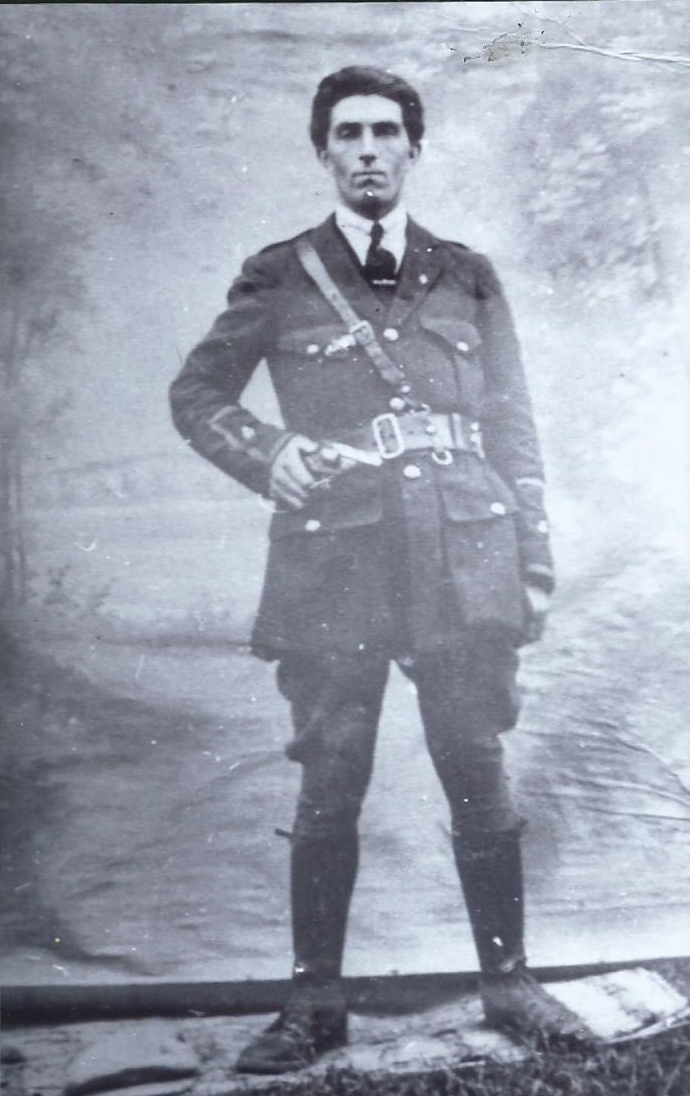 When
the Treaty was signed on 6 December 1921, Pat decided on a military
career and although the home farm was intended for him, he wrote to
Andrew (recently emigrated to America) offering it to him.
While Pat was on the republican side on the question of the treaty,
local volunteer commanders whether they be Republican or Free-State
assumed control from the departing British. Pat was selected
for and served as a cadet in the Officers Training College at Ennis
under Michael Brennan (later Major General Brennan) during February
and March 1921, at which point John Keating took over as O.C.
Kilnamona. Pat commanded the taking over
of the Barracks in Lisdoonvarna from the evacuating British forces
early in 1922 and subsequently he joined with Cmt. Joe Barrett
(Kilrush) and Seán O'Grady (later
Fíanna Fáil
T.D., Clare
member of Irish Parliament) at the Ennistymon Barracks. He was
rigged out in full military uniform with Sam Brown belt and
appointed Quarter Master of the barracks and later O/C with rank of
Captain and over 60 men under his charge (cf Pat's Application for a
Service Certificate in Dept of Defence, 1935). When
the Treaty was signed on 6 December 1921, Pat decided on a military
career and although the home farm was intended for him, he wrote to
Andrew (recently emigrated to America) offering it to him.
While Pat was on the republican side on the question of the treaty,
local volunteer commanders whether they be Republican or Free-State
assumed control from the departing British. Pat was selected
for and served as a cadet in the Officers Training College at Ennis
under Michael Brennan (later Major General Brennan) during February
and March 1921, at which point John Keating took over as O.C.
Kilnamona. Pat commanded the taking over
of the Barracks in Lisdoonvarna from the evacuating British forces
early in 1922 and subsequently he joined with Cmt. Joe Barrett
(Kilrush) and Seán O'Grady (later
Fíanna Fáil
T.D., Clare
member of Irish Parliament) at the Ennistymon Barracks. He was
rigged out in full military uniform with Sam Brown belt and
appointed Quarter Master of the barracks and later O/C with rank of
Captain and over 60 men under his charge (cf Pat's Application for a
Service Certificate in Dept of Defence, 1935).
Over: Pat in
the military uniform, May 1922 when during the truce on an officer
training course under General Michael Brennan for a career in the
new state army
Br Thomas (1989) writes: "On the day
of the departure of the British all Parliament Street and Main
Street was lined up with lorries full of R.I.C. men, Tans,
Auxiliaries and soldiers. When we were coming out of school a group
of us stood opposite the R.I.C. barracks watching the departure but
as we stood there the last act of the British before moving off was
to fire a hand grenade (Mills bomb!) into our midst wounding several
of my companions. Those of us unhurt ran for our lives down side
streets and waited until the last of the army was gone." Is this the
same incident recounted in 'Politics and Irish Life 1913 -1921'
(David Fitzpatrick, 1977,1998), which states that the Ennistymon
barracks was given over on February 1st 1922 after Head Constable
had publically denounced 2 constables for throwing Mill bombs at
school children screaming 'Up Rinneen, Up the IRA' ?
Many alluring offers
were made to Pat to entice him to join with the Free-State cause
including a number of offers of a commission in the Free-State army,
a large farm in County Meath, and the post of rate collector in Co
Clare, which he declined.
Pat was in Ennistymon Barracks up to the end of June 1922 when the
Free State soldiers, which far outnumbered them, gave notice that
they were to attack the barracks. The Republicans withdrew
setting fire to the barracks and from then were on the run.
Subsequently he was missing and it was rumoured that he had been
killed at an ambush near Dromoland. However, after 6 weeks everyone
was surprised to see him return home (for more information see Pat's
Testimonial below).
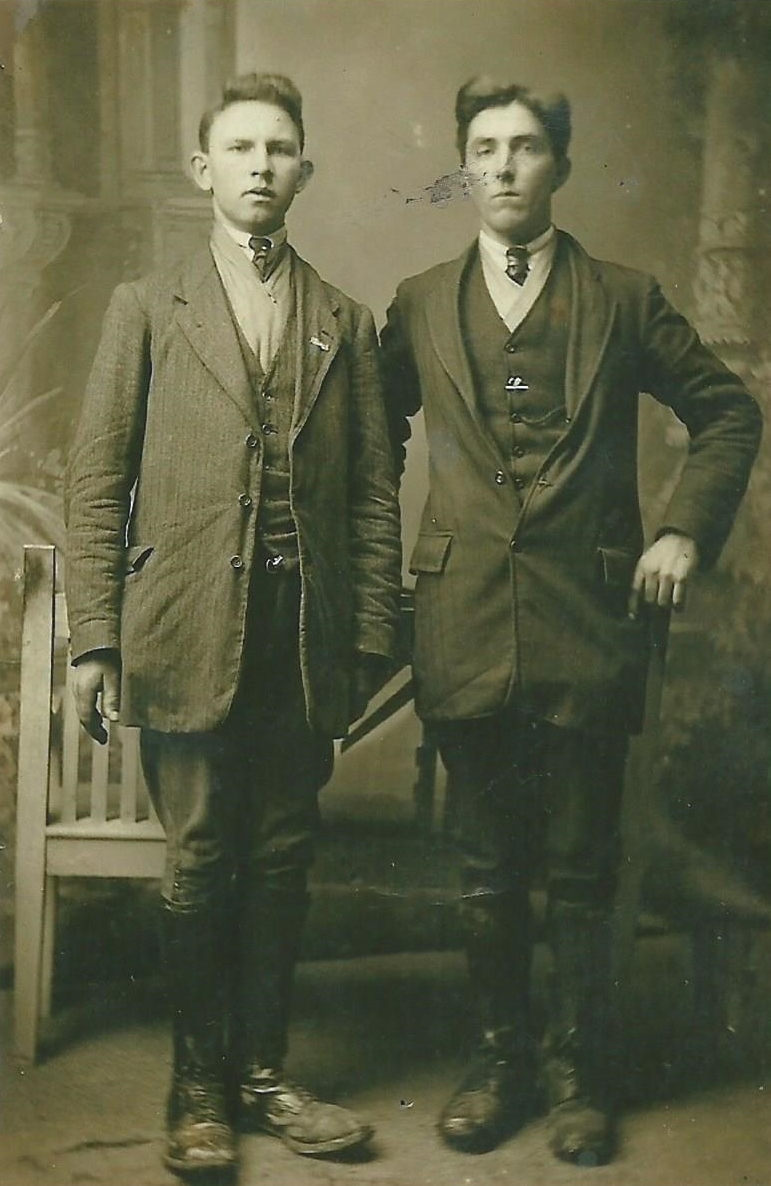 Pat remained on the run from the Free State
authorities and for a time went into hiding at the O'Dea farm in
Ahasla, which was remote from the main thoroughfare. This was
subsequent to Cornie O'Dea's tragic death on 22nd August, 1922 (see
O'Dea).
He and fellow republicans used to meet clandestinely on those boggy
wetlands. According to Willie Hegarty, Ahasla (2007, then aged
87 years) it seems that the Civic Guards (from the Maurice's Mills
Barracks) arrived one day at the neighbouring Hegarty house on
routine surveillance. On enquiring about the family further in the
roadway, the Guards were told of the recent O'Dea sad bereavement
leaving a widow with two young daughters. The upshot of this was
that the police refrained from visiting the O'Dea house on that
occasion. Pat remained on the run from the Free State
authorities and for a time went into hiding at the O'Dea farm in
Ahasla, which was remote from the main thoroughfare. This was
subsequent to Cornie O'Dea's tragic death on 22nd August, 1922 (see
O'Dea).
He and fellow republicans used to meet clandestinely on those boggy
wetlands. According to Willie Hegarty, Ahasla (2007, then aged
87 years) it seems that the Civic Guards (from the Maurice's Mills
Barracks) arrived one day at the neighbouring Hegarty house on
routine surveillance. On enquiring about the family further in the
roadway, the Guards were told of the recent O'Dea sad bereavement
leaving a widow with two young daughters. The upshot of this was
that the police refrained from visiting the O'Dea house on that
occasion.
- -
-
-
Over: Comrades in Arms: Formal photo of Pat (right) and his first
cousin (once removed) Frank Keane, both active in the IRA. Probably
dated ~1919/1920 as Frank (b. 1902) appears to be about 17/18 years
of age and thus Pat (b. 1894) would be about 25 years!
-
The Republicans decided to retake the new
Barracks at Ennistymon and Pat was asked to undertake the task.
Br Thomas goes on to write (my brackets): "Pat then contacted Mylie
Keane (cousin) who had joined the Free State army (known then as the
National troops) as a soldier and was stationed at Ennistymon
temporary barracks now the Ennistymon hospital. The plan
was that on the night (during August 1922) Mylie while on sentry
duty would allow the republicans access to the barracks.
However a dispatch containing the information was found hidden in
the sole of the shoe of Pat Morgan (Lavareen, Ennistymon, a cousin
of Pat's on Morgan side) who was carrying the document."
Pat arrived at Morgans of Knocknagraga (cousins) to prepare for the
takeover of the barracks but owing to the information getting
out (believed to be loose talk by Mylie to comrades in drink!) the
house was surrounded by Free State soldiers in the early hours of
the morning. Pat who had a revolver under his pillow, had time
to push the revolver down into a sack of flour. However one of
the soldiers found the gun and put it in his own pocket 'probably to
sell'. If the revolver was found by one of the officers Pat
would have been executed because of an official ruling to execute
anyone carrying firearms."
[Shown below is the
actual Old IRA medal issued to Pat in 1941 by the Government of
Ireland as a member of the Irish Volunteers who were engaged in the
War of Independence and who had given valuable service.
Depicted on the
medal is a Volunteer in uniform with gun standing to attention
surrounded by crests of each of the four provinces with prominent
ÉIRE (Ireland) and inscribed
at the bottom with the words
cogadh na
saoirse (war of independence).
The word
cómhrac
(struggle, combat) is inscribed on a bar attached to the pennant and
this bar was issued to those only who had actually given active and
armed service (see
here)].
Internment Camp
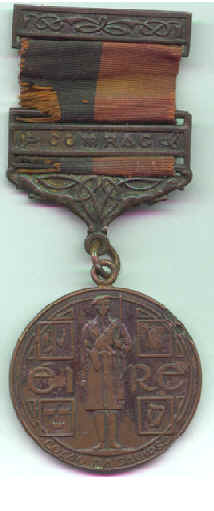 A
report in the 'Clare Champion' of August 12th 1922 listed among the
21 arrests of irregulars in the Mid-Clare Brigade area were Pat
Keane, Kilnamona and his cousin Pat Morgan, Lavereen, Ennistymon. (Ed.:
The dating of this newspaper report (courtesy of Br Willie Morgan)
seems to be at variance with that recounted by Pat in his
Testimonial Statement reproduced below and with that of Willie
Hegarty above in relation to the O'Dea recently bereaved family
(Cornie O'Dea died on August 20) - the newspaper publication date needs further
checking out!) A Clare Champion report on September 2nd told
of a large number of republican prisoners rounded up and captured in
the South Western Command area who had been transferred from
Limerick prison to their destination of internment via steamer down
the Shannon (land transfer must have been considered too risky). Pat
was thus sent to Gormanstown Internment Camp, Co. Meath on 8
September 1922 (
"Location of prisoners Book"
GC 8/9/22, Military Archives, Cathal Brugh Barracks; GC, Gormanstown
Camp). Although no record of date of release is available, Pat's own
Testimonial Statement (see below) states this to be December 1923,
which is supported in part by the date on his Gormanstown Education
Certificate reproduced below (October 10th 1923). Thus the length of
his prison camp incarceration is reckoned as fifteen months. To put
his release date in context: The republican ceasefire and dump
of arms order occurred on May 24th 1923, and prisoners were
gradually released (3,000 per month), those prisoners considered the
greater danger to the State released later up to December 1923 or
the general amnesty early 1924 (see in
McGuffin (1973)
his ref. 10). A
report in the 'Clare Champion' of August 12th 1922 listed among the
21 arrests of irregulars in the Mid-Clare Brigade area were Pat
Keane, Kilnamona and his cousin Pat Morgan, Lavereen, Ennistymon. (Ed.:
The dating of this newspaper report (courtesy of Br Willie Morgan)
seems to be at variance with that recounted by Pat in his
Testimonial Statement reproduced below and with that of Willie
Hegarty above in relation to the O'Dea recently bereaved family
(Cornie O'Dea died on August 20) - the newspaper publication date needs further
checking out!) A Clare Champion report on September 2nd told
of a large number of republican prisoners rounded up and captured in
the South Western Command area who had been transferred from
Limerick prison to their destination of internment via steamer down
the Shannon (land transfer must have been considered too risky). Pat
was thus sent to Gormanstown Internment Camp, Co. Meath on 8
September 1922 (
"Location of prisoners Book"
GC 8/9/22, Military Archives, Cathal Brugh Barracks; GC, Gormanstown
Camp). Although no record of date of release is available, Pat's own
Testimonial Statement (see below) states this to be December 1923,
which is supported in part by the date on his Gormanstown Education
Certificate reproduced below (October 10th 1923). Thus the length of
his prison camp incarceration is reckoned as fifteen months. To put
his release date in context: The republican ceasefire and dump
of arms order occurred on May 24th 1923, and prisoners were
gradually released (3,000 per month), those prisoners considered the
greater danger to the State released later up to December 1923 or
the general amnesty early 1924 (see in
McGuffin (1973)
his ref. 10).
One day, on a
day release, Pat visited his brother Thomas, who had recently
joined the Irish Christian Brothers (14 August 1923) and was a
postulant at the Order's Baldoyle Novitiate, a village northeast of
Dublin city. Brother Thomas recalled that his trench coat
contained the remains of clay from the digging of a dugout or escape
tunnel.
When completing (in the mid-1930's) his LIFE
CERTIFICATE form, a requirement for military pension purposes, Pat
dated his retirement from the Defence Forces (note: not the National
Army) rather surprisingly as 1925 having Rank of Captain (Dept of
Defence archives).
- - - - - - - - - - - - - - -
We are fortunate to have access to Pat's account of his activities during this period of national
strife in his own testimonial statement when applying for a Service
pension in 1935. For this go to
here. Additional
information supplied by Pat on that occasion vis-a-vis Kilnamona IRA
company officers and men are listed in the Clare County Library
website.
- - - - - - - - - - - - - - -
Academic Side of Pat
Pat was an educated person for that period. He attended the
Christian Brothers Secondary School in Ennis for a period.
Although he lived a distance of 5 miles from Ennis, he is said to
have walked daily to school. It is not known how far he
progressed in the secondary school cycle but in the 1911 census
(National Archives, Dublin) he was described as a farmer's son
(aged 17 y.) rather than as a scholar as his younger school going
siblings were so described.
Apart from digging escape tunnels, Pat also productively occupied
his time in the Gormanstown Interment Camp to become proficient in
the teaching of the Irish (Gaelic) language. The certificate he
received from there using the Gaelic form of Pat's name states as
follows:
 GORMANSTOWN
INTERNMENT CAMP GORMANSTOWN
INTERNMENT CAMP
EDUCATION
BOARD
CERTIFICATE
This is to Certify that Pádraig Ó Catháin of Cíll na
Móna has been in regular attendance at the special Class
for Teachers of Irish; that he has been examined and has
satisfied the Examiners of his competency to teach
Irish. He has twelve months practical experience
in teaching in the Irish Classes and has successfully
prepared Students for the Fáinne Examination.
Signed on behalf of the Board:
Seán Ó Ceallaigh, Chairman
Séamas P. Ó Cadhla, O.S.,
Director of Special Classes
John J. Lynch B.A. (Hons) N.U.I. Sec.,
Inspector of
Irish Classes
Dated 10th Oct. 1923
|
* Seán Ó Ceallaigh
(S.T. O'Kelly) became the 2nd and 3rd
President of Ireland,
1945-59. (Click on inset to enlarge
original certificate)
After release from Gormanstown Internment
Camp, Pat taught Irish locally in Kilnamona, Dysart and Toonagh but
he found that there was "no future in it" (Br Thomas, 1989).
Later, in the mid-twenties, he was offered entry to the Teacher
Training College to train as a national teacher. This would
require a further year away from home. Being lately married
and having the first signs of coronary thrombosis (at the age of 33
believed to be the result of outdoor hardship while 'on the run'
from the authorities), he did not pursue it further.
Breaking
away from the futile militant Republicanism, and turning to
constitutional politics, he participated in the founding in Clare of
the national political party of
Fíanna Fáil (Soldiers of
Destiny) under Éamon de Valera in 1926. This party came to
power first in 1932 and still continues to be a major force in Irish
politics. It is interesting to note that at the time of his
untimely death in 1952, he was vice Chairman of the Clare
Cumann
(branch) of Fíanna Fáil
and also Chairman of
the local (Kilnamona) branch.
Lighter Side of Life in the
Volunteers
Life in the volunteers was not always
serious. A story is told that at an all-night vigil for a
local deceased person, a young man from outside the parish was very
vocal about his commitment to the cause of the volunteers expressing
a wish to join the local column. At the wake, the matter was
brought to the attention of Pat, the local Commanding Officer, and
it was 'agreed' that he must first prove his valour.
That very night, the task was set for him to wrestle a shotgun from
a local land owner. However, if he failed, he was to be
court-martialled and shot immediately by a firing party.
In the meantime Pat
dispatched a local 'volunteer' to forewarn and assist the gun owner.
It was little wonder the young aspirant failed in his mission and
sentenced to be executed. The man was told to make his peace,
while the firing party debated as to the appropriate firing distance
from target. The poor soul was quietly advised to run away while the
firing squad argued. He was never seen in the parish again.
Later
Initiatives
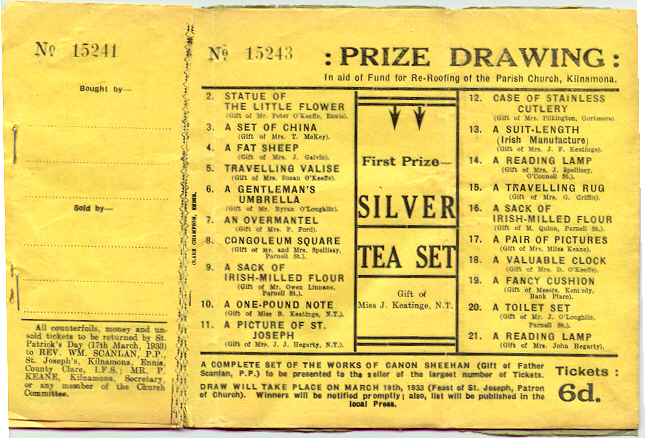 Pat
participated in the life of the Kilnamona parish. He was for
instance Secretary to the St Joseph's Church, Kilnamona, restoration
project in 1933. Apart from re-roofing, the walls were raised
by two feet and a gallery installed (this gallery was removed in a
later renovation project in the 1970's, the numbers attending
services being smaller due to the introduction of an extra
week-end Mass after Vatican 2 and more mobile parisheners having
occasion to attend Church Services in Ennis). An original
raffle ticket, shown over, to raise funds for the restoration
demonstrates wide support for the undertaking. (Historical note:-
interestingly the return address on the counterfoil gives the state
as I.F.S. i.e. Irish Free State). Until his death, Pat with
neighbour Paddy Brody, assisted the parish priest in the seasonal
collection of church dues (stipends) levied on parishioners at
Christmas, Easter and harvest times*. Pat
participated in the life of the Kilnamona parish. He was for
instance Secretary to the St Joseph's Church, Kilnamona, restoration
project in 1933. Apart from re-roofing, the walls were raised
by two feet and a gallery installed (this gallery was removed in a
later renovation project in the 1970's, the numbers attending
services being smaller due to the introduction of an extra
week-end Mass after Vatican 2 and more mobile parisheners having
occasion to attend Church Services in Ennis). An original
raffle ticket, shown over, to raise funds for the restoration
demonstrates wide support for the undertaking. (Historical note:-
interestingly the return address on the counterfoil gives the state
as I.F.S. i.e. Irish Free State). Until his death, Pat with
neighbour Paddy Brody, assisted the parish priest in the seasonal
collection of church dues (stipends) levied on parishioners at
Christmas, Easter and harvest times*.
---------------------------------------------------------------------------------------------------
*Apart from their abilities (Paddy Brody was the district
Rate Collector for the Local Authority), one might also speculate
that this particular pairing may have been an astute move by the
then parish priest as each represented opposite sides in regard to
the Treaty and politics. The sympathy of the parish had broadly
divided into two-thirds pro-Republican and one-third Free State. As
a counterpoint interestingly Pat's own testament from 1935, it seems
some 65% of Kilnamona volunteers remained neutral during Civil War,
less than 25% were active on republican side and some 10% joined
National Army or Civic Guards (see
Clare Library).
-----------------------------------------------------------------------------------------------------
Supervisor with
Department of Agriculture
Pat sat a national examination for Temporary Assistant Supervisor
(Cattle and Meat) during
the so-called Economic War between Ireland and Britain in the
mid-1930's, when the market for Irish meat produce to England was
shut off in a dispute over the unilateral ending by Ireland of
payment of land annuities to the UK. This caused much depression in
farming in Ireland over several years and led to the
institution by the Government of a Free Beef Scheme to needy people,
which required supervision and monitoring. Pat's
employment in this position began on January 1st 1935 and was in the
position for about three years.
The particular exam for
entry to the post was of a high standard, competition was strong,
even university graduates applying - his daughter Philomena
recalls seeing the examination papers after Pat's death (which he
had retained over the years), and although by then herself a trained
National Teacher, deemed the maths and the English essay on mounting
'an agricultural show in your own locality' as particularly
difficult (for the time).
There were 4,200 applicants for 120 places.
Research with the Civil Service Commission has shown that following
the written examination 285 were placed in the order of merit for
call to interview. From this Pat secured 65th placing. Ultimately
141 names were sent to the Dept of Agriculture between 12/1934
and 12/1935 (File reference CS21/86/34). Pat as Temporary
Supervisor (Cattle and Meat) over the next three years was posted to
Cliften from January 1935 (where he lodged in the Ardbear Hotel),
and later transferred to Tuam, County Galway (attempts to discover
his personnel file among the many in the Department of Agriculture
have been so far unsuccessful). During that time Pat's weekly wage
was £5. 10s, a very good remuneration for the time (extracted from
form which Pat filled for his Service Certificate, see below)!
During his period as
Inspector, Pat acquired a Ford motor car, an unusual spectacle in
the 1930's - probably two others existed in the parish at the
time, the priest and the school teacher. In fact he seems to have
graduated to a second car, one a two seater and the other a model
T-Ford, probably both acquired second hand in which he regularly
came home. He was also one of the first in the parish to
acquire (in 1937) a battery-operated radio, or a wireless as it was
known (This he had to relinquish for a time during Second World War
years due shortage of batteries). Locals often gathered on summer
Sunday afternoons to listen to live commentaries (by the up and
coming famous gaelic games and racing broadcaster, Micháel O'Hehir)
on the major hurling and gaelic football matches of the day -
occasionally batteries were known to expire before the game ended
which did not go down well with the frustrated listeners!
The Penultimate Years
Pat joined the Local Defence Forces (LDF, now known as
An Forsa Cosanta Áitiúil),
a volunteer reserve force founded at the onset of the 'emergency'
years of the 2nd World War,
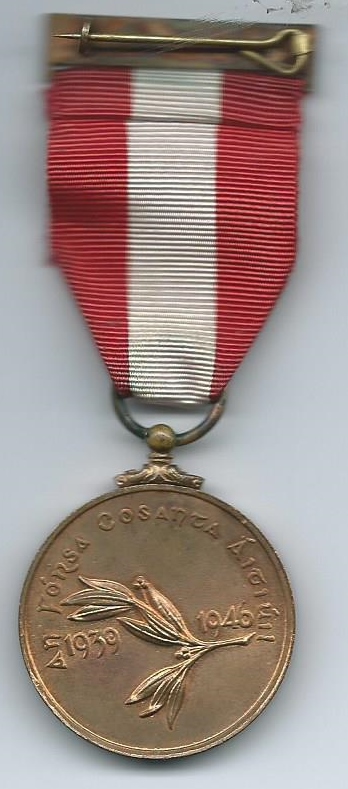 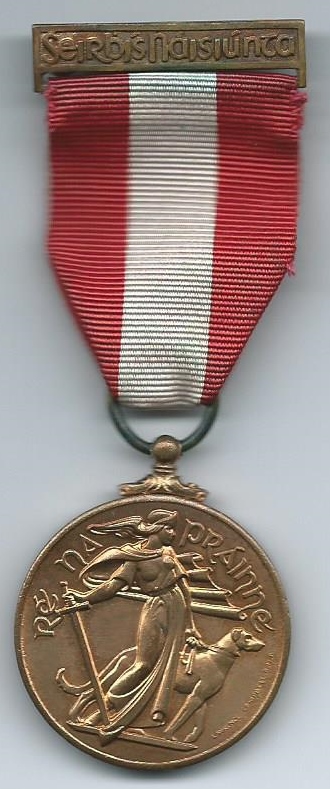 1939-1945.
The LDF, a Part-time Defence Force (PDF), was organized
on 'a regional basis and designed to support the regular army by
point defence and guerrilla activities, surveillance, intelligence
reports, road obstructions, etc'. His children remember
army supplies for the unit (kaki army wear and other paraphernalia,
e.g. carrier bags) stored for distribution in his home during the
period, and also recall bicycle runners delivering dispatches to him
as part surveillance and communication exercises.
On enquiry with the Dept of Defence
(2011) a certificate of Pat's Service record in the LDF of
Óglaigh na hÉireann' (Defence Forces) showed him as having a
Service No. of S/86876, Rank of A/Leader (Area Leader), date
of Enlistment, 11 Jun 1940, date of Discharge, 31 Mar, 1946, and as having
served 5 years and 294 days; Finally his Military Conduct was judged
to be Very Good.
As any medal he may have been awarded for his services was not
available to this webmaster in 2011 (he perhaps did not apply for
one at the time of their issue), on enquiry with the dept of
Defence, Pat was deemed to be entitled to a
replacement issue of the Emergency Service Medal
& 2 Bars (L.D.F.); unfortunately the bars
(which indicated multiple of years of service, not rank) were
however no longer in stock (see medals above). 1939-1945.
The LDF, a Part-time Defence Force (PDF), was organized
on 'a regional basis and designed to support the regular army by
point defence and guerrilla activities, surveillance, intelligence
reports, road obstructions, etc'. His children remember
army supplies for the unit (kaki army wear and other paraphernalia,
e.g. carrier bags) stored for distribution in his home during the
period, and also recall bicycle runners delivering dispatches to him
as part surveillance and communication exercises.
On enquiry with the Dept of Defence
(2011) a certificate of Pat's Service record in the LDF of
Óglaigh na hÉireann' (Defence Forces) showed him as having a
Service No. of S/86876, Rank of A/Leader (Area Leader), date
of Enlistment, 11 Jun 1940, date of Discharge, 31 Mar, 1946, and as having
served 5 years and 294 days; Finally his Military Conduct was judged
to be Very Good.
As any medal he may have been awarded for his services was not
available to this webmaster in 2011 (he perhaps did not apply for
one at the time of their issue), on enquiry with the dept of
Defence, Pat was deemed to be entitled to a
replacement issue of the Emergency Service Medal
& 2 Bars (L.D.F.); unfortunately the bars
(which indicated multiple of years of service, not rank) were
however no longer in stock (see medals above).
Postscript: Additional information has come to
light regarding Pat's military potential as recalled in 2014 by his
eldest daughter Angela (aged 88 years): in the early 1940s, i.e.
during WW II, while in her secondary school years Angela
recalls her mother telling her that her father Pat had been offered
a post in the state army, i.e. Regular Defence Forces (RDF), but
after due reflection did not take up the offer because of his
ongoing heart condition. This would appear to have been the
second time Pat was offered an officer post in the Irish army (the
first being during the Civil War).
Pat supplemented his
income to improve living conditions from the modestly small farm.
He was one of the first producers in the district to supply milk to
the newly built local branch of the North Clare community creamery
in the mid-1930's (e.g. his milk supply Register at the creamery was
numbered 1). He erected a substantial two-storied house in the early
1930's almost entirely with the assistance of a government grant
(costs £150 less Government grant £80) and in the 1940's, he availed
of farm improvement grants for e.g. the building of farmyard
outhouses and double clad dry stone walled paddock enclosures.
During the 'emergency'
years of World War 2, compulsory tillage quotas were mandatory for
farmers irrespective of land suitability for cultivation. Pat
took on extra off-farm tillage (i.e. fulfilling a neighbour's quota)
to supplement his crop production - it was hard work for his
young family manually snagging (thinning) turnips and fodder beet or
to keeping those weeds and nettles at bay (one such cereal weed was
known locally as praiseach
(destructive) weed)!
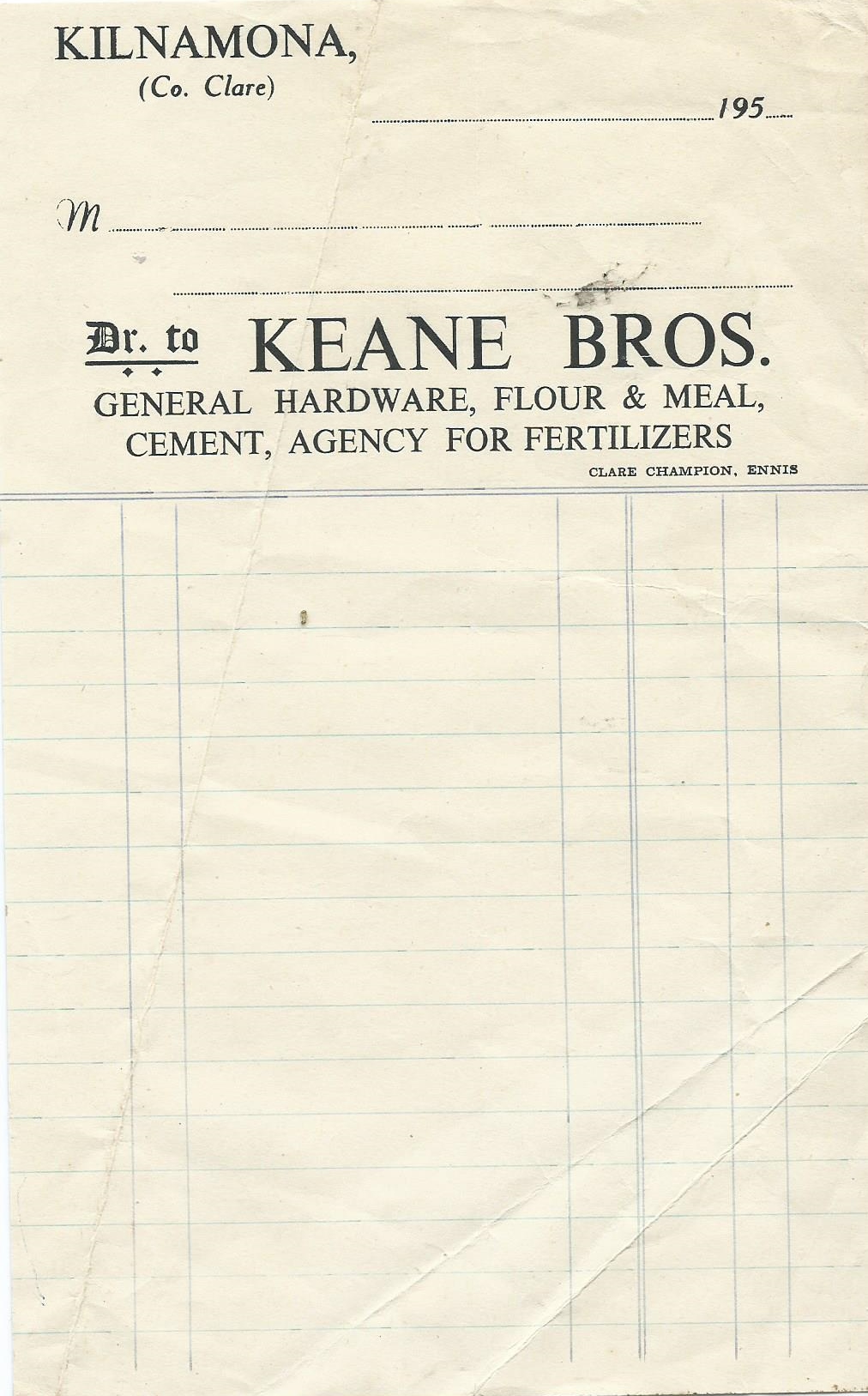 Periodic income was earned from the Clare County Council, for
limestone quarried on his land (based on a volume or cubic yard
basis) used in road maintenance. In 1942/43, he supplied fresh
milk (more profitable than creamery returns) to an institution in
Ennis; ceasing this operation after a season he returned in
1949 to twice-daily shop and house-to-house milk rounds in Ennis
(the latter initiative being continued up to the mid-1990's).
He set up a farm supply store at Ballymongaun providing animal feed
provisions, fertilizer and limited hardware for sale to the local
farming community. The purchase in 1950 of a horse drawn
potato sprayer, then
new to the market, for hire to farmers and manned by his young
family, was another source of seasonal income. At the onset of
the economic upturn of the 1950's, sadly, Pat died in 1952. Periodic income was earned from the Clare County Council, for
limestone quarried on his land (based on a volume or cubic yard
basis) used in road maintenance. In 1942/43, he supplied fresh
milk (more profitable than creamery returns) to an institution in
Ennis; ceasing this operation after a season he returned in
1949 to twice-daily shop and house-to-house milk rounds in Ennis
(the latter initiative being continued up to the mid-1990's).
He set up a farm supply store at Ballymongaun providing animal feed
provisions, fertilizer and limited hardware for sale to the local
farming community. The purchase in 1950 of a horse drawn
potato sprayer, then
new to the market, for hire to farmers and manned by his young
family, was another source of seasonal income. At the onset of
the economic upturn of the 1950's, sadly, Pat died in 1952.
Over: Copy of a Store Invoice pad from the mid-1950s, a few
years after Pat's death
Reader of
News and Historical Events
Pat was a regular reader of the national daily newspaper,
The Irish Press,
which was available in Ennis some 4 miles away. If on any day a
family member was not travelling to Ennis, a passing neighbour would
be asked to oblige. He also liked to read the current books on
the Irish war of independence that were being published for the
first time in the late 1940's. He read aloud by the fireside
to his family and gathered neighbours, one chapter per night, such
books as 'My fight for Irish Freedom'
by Dan Breen, T.D. (Teachta Dála,
Member of Parliament) for Tipperary and
'Guerrilla Days in Ireland' by Tom
Barry (Cork), etc.

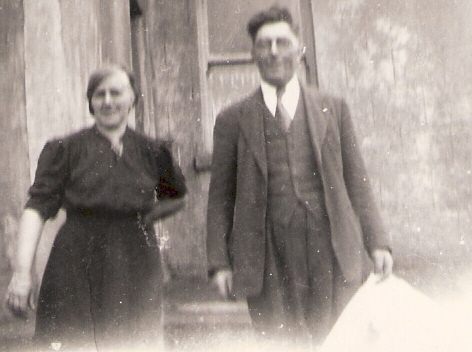
-
-
-
Above: Bridget and Pat, 1947 and with newspaper in hand, 1949.
Photos taken by nephew John Kane, Waterbury, Conn. when visiting
Ireland from the US army base in Germany, and again on a return
visit on his honeymoon.
Not
wanting to pass on extreme republican attitudes to his children, Pat
rarely spoke of his military activities. However, in reaction to
some ambush incident recounted in one of the books, probably Tom
Barry's, Pat recalled to the listeners a similar engagement mid-May,
1921 in which he had taken part. This was an ambush laid for a group
of Auxiliaries recently transferred from Cork who regularly
travelled on tender between Ennis and Corofin. It seems that the
then IRA commanding officer (as it happened it must have been
under (mid-Clare) Brigade O.C., Frank Barrett (see
report 4;
or at BHM.ws1326.pdf on page 49 at
Bureau of Military History)) had placed his armed men on either side of the road
behind ditch walls across from each other. Pat reflected that
thankfully the Tans did not pass the way on the day as otherwise the
IRA company would have shot each other in the crossfire. It seems
this may have been the last engagement before the truce.
Life's Review
Pat was not an extreme republican. Thankfully the divide in
County Clare between republicans and Free State forces, was not as
marked as in some counties. For example, during the
civil war Pat made a successful plea to the Free-State forces
(perhaps via
Mick Hegarty*) to spare from court martial Mylie Keane, a local
'Free-State' soldier who as stated previously had agreed to assist
in the retaking of Ennistymon barracks by republicans.
-------------------------------
*Mick Hegarty was Captain, 2nd
in Command, 28 Batt., National Army, Gort 1923/4. His father
Patsy was pay officer, but 'wouldn't wear uniform' (information
supplied to the writer in 2005 by (the then one of only two still
surviving from old IRA active times) Lt Colonel Seán Clancy,
originally from Clonlara, SE Clare, then in his 105th
year; Seán died September 2006).
-------------------------------
Locally, as a young man, Pat was
thought of by the older generation as somewhat opinionated (at a
time when
young people should be seen and not heard
by their elders)! Later in life, Pat was always on hand to
help neighbours with the filling out of difficult official forms,
e.g. grants or old IRA pensions, which required to be done from time
to time. His eldest daughter, Angela, recalls that more than
once in the late 1930s a 'queue' of former IRA men developed outside
the front door of his home (probably on Sundays and probably when
Pat was home on visits from his post in Cliften, i.e. 1936/37 ) to
help in filling and witnessing their application forms for the Old
IRA pension - results of his guidance was said to have led to many
positive outcomes for the applicants (this can be verified, perhaps
in the not too distant futere, when these such applications are
released for public viewing). Through the years his advice was
also much sought after on various mediation
matters, with great success but sometimes incurring some knock-on
embroilment*.
-----------------------------------------------------------------------------------------------------------------
*The lingering after effects of the
civil war; the inevitable land disputes (Shallee, Ballymongaun
distributions including a local resentment at his purchase in the
early 1930s of Keating land at Caherbannagh; a petty contretemps
(including being the object of gunshot warnings by
hothead young protagonists) that spilled over into the wider parish in the
late 1930's between the local principal national school teacher
(with whom Pat was friendly) and the said teacher's neighbours.
-----------------------------------------------------------------------------------------------------------------

Pat's signature to a loan
document, November 1928
Rambling House Story
 Before dance halls came into vogue, as was the custom of the time,
wren-boy dances and
soirées at Christmas time, and
occasional dances at other times, were in their turn held in Pat's
house (often agreed to after token resistance!). His house was also
a focal point or 'rambling house' for the local youth for
their nightly social gatherings, card playing, ring board games
(perhaps an added attraction was the oft-times presence of two
daughters!). Before dance halls came into vogue, as was the custom of the time,
wren-boy dances and
soirées at Christmas time, and
occasional dances at other times, were in their turn held in Pat's
house (often agreed to after token resistance!). His house was also
a focal point or 'rambling house' for the local youth for
their nightly social gatherings, card playing, ring board games
(perhaps an added attraction was the oft-times presence of two
daughters!).
-Pat
with daughter Philomena (right with school/digs friend Maura O'Gorman
(left)) outside a store and bar in Parnell St. Ennis.
Photo taken by Pat's American nephew John during John's first visit to
Ireland while serving in the US army in Germany in 1947. (Note:
although the shop was owned by Gerard and his sister Gelly
(Geraldine) Duignan,
their mother's original family name Kennealy was still retained on
the shop front even for a further two to three decades.)
Pat did
not always participate in the card games. Instead, he more likely
continued to read his daily newspaper by the warm fireside. Now on
either side of the fire were cushioned concrete hob seats where the
children sat at night-time. One evening when a more youthful
would-be card player arrived late, and no vacant chair to sit on, he
was 'advised' by his elders to approach Pat for his chair inviting
him to take to the hob. They awaited for what the knew would be a
chastening retort ('go away you faiker!') to the naive aspirant.
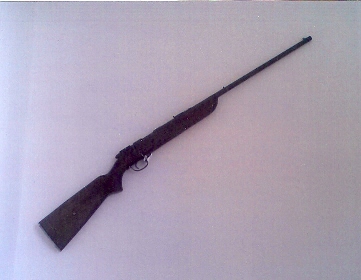 As
was the custom among the farming community, Pat held a
licensed gun for culling excessive wildlife on the farm and
hunting. The point 22 riffle shown over was that owned
by Pat and is still in the possession of a member of
the family as a memento but disabled for licensing purposes. As
was the custom among the farming community, Pat held a
licensed gun for culling excessive wildlife on the farm and
hunting. The point 22 riffle shown over was that owned
by Pat and is still in the possession of a member of
the family as a memento but disabled for licensing purposes.
The Final years
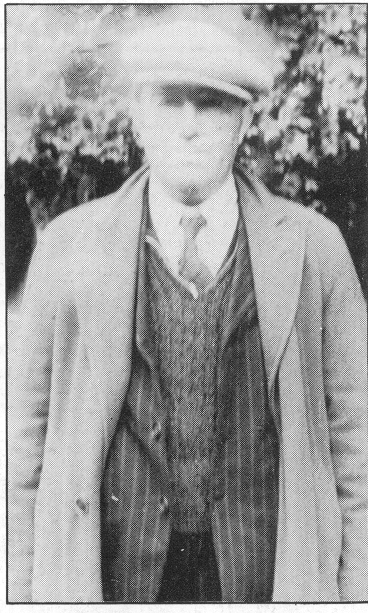 As
well as the heart related condition, Pat suffered from sciatica in
later years and annually holidayed for a week in Lisdoonvarna at
autumn time to sample the curative waters of the sulphur baths, as
well as other liquids one presumes!
(photo of Pat taken in Lisdoonvarna in 1948).
He died from coronary thrombosis after a short illness at Ennis
general hospital at the relatively young age of 57 years on January
18th, 1952. His coffin was borne shoulder high from the hospital
mortuary by his comrades and neighbours for over a half-mile before
continuing onwards by hearse to Kilnamona Church. Pat's death
occurred six weeks after his brother Andrew died, November 30th,
1951, aged 51 years. Another brother Martin had predeceased
them in U.S.A. by two years, both brothers having succumbed to
tuberculosis - the scourge of that era. As
well as the heart related condition, Pat suffered from sciatica in
later years and annually holidayed for a week in Lisdoonvarna at
autumn time to sample the curative waters of the sulphur baths, as
well as other liquids one presumes!
(photo of Pat taken in Lisdoonvarna in 1948).
He died from coronary thrombosis after a short illness at Ennis
general hospital at the relatively young age of 57 years on January
18th, 1952. His coffin was borne shoulder high from the hospital
mortuary by his comrades and neighbours for over a half-mile before
continuing onwards by hearse to Kilnamona Church. Pat's death
occurred six weeks after his brother Andrew died, November 30th,
1951, aged 51 years. Another brother Martin had predeceased
them in U.S.A. by two years, both brothers having succumbed to
tuberculosis - the scourge of that era.
Photo of Pat taken in Lisdonvarna, probably 1950
 Pat was buried in January 1952 in
the old cemetery, Kilnamona (see first section) with military
honours provided by Old IRA comrades and firing party under the
command of Paddy Con McMahon, Ennis (former I.R.A. Mid Clare
Brigade, 1st Batt. O.C.). Shown over is the spent bullet
casing of one of the volley's fired on that occasion. Pat was buried in January 1952 in
the old cemetery, Kilnamona (see first section) with military
honours provided by Old IRA comrades and firing party under the
command of Paddy Con McMahon, Ennis (former I.R.A. Mid Clare
Brigade, 1st Batt. O.C.). Shown over is the spent bullet
casing of one of the volley's fired on that occasion.
From the Clare Champion, January 26th, 1952
compiled by Bro. Thomas and local persons Paddy
O'Keeffe and Mick Keane (Kane)
The
death of Mr. Patrick Keane, Kilnamona, which took place after a
brief illness, at the Co. Hospital on Friday 18 inst., removes one
more veteran from the ranks of the Old I.R.A.
The deceased man was an energetic
organiser of the Irish Volunteer Force in the early days, and in
Easter 1916, he was in his place when the Volunteers in Clare
expected the order for insurrection.
In 1918 he was sentenced to
three months’ imprisonment for what was described in the Court as “a
tornado of folly which had gripped the country and had swept the
people off their intellectual hinges”, but which eventually achieved
the independence of Ireland.
On
his release he was appointed Captain of A Coy., 3rd
Batt.,Mid-Clare Brigade, where his enthusiasm and organising
abilities were responsible for making his Coy. the most active and
efficient in the area. He took part in practically all the major
engagements within the Brigade area, including the disarming of the
British soldiers in Ennis, the taking of Ruan Barracks and the
Monreel ambush.
When the Treaty was signed, he was a
commanding officer in the taking over of the Lisdoonvarna Barracks
from the Black-and-Tans. Afterwards he was transferred to Group
Headquarters in Ennistymon, where he remained until the burning of
the barracks in June, 1922. Two
months later he was arrested in Ennistymon, and having spent a
short term in Limerick Jail he was removed to Gormanstown Camp.
During his term in jail he perfected his knowledge of
Irish (Gaelic) and thus was certified by the present President of
Ireland, Mr. Sean T. O’Kelly, as a qualified teacher of Irish.
He then devoted his spare time to teaching the
language to the youth of his own parish, Kilnamona, and to those of
the adjoining parishes of Dysart and Toonagh.
At the foundation of the Local Defence Forces, he was the
first to answer the call, and thus inspired the youth with the
courage to defend the freedom already won. In his political career,
he had occupied the position of Vice-Chairman of Comhairle Dail
Ceanntair (for Co. Clare).
On Friday evening the remains draped in the
tricolour and accompanied by a very large following, was brought to
Kilnamona Parish Church, and on Saturday morning, Solemn Requiem
Mass was celebrated by Rev. Fr. Hayes*, and the coffin was borne by
his Old Comrades of the I.R.A. to the cemetery.
A firing party of the Mid-Clare Brigade, under P.C.
McMahon, Ennis, fired three volleys over his grave, and thus gave
the deceased the honour of a military funeral.
Thus has passed one who has truly
imbibed the spirit of Pearse and who, notwithstanding alluring
prospects, never deviated from these principles.
---------------------------------------------------------
*Catholic Curate, Inagh; Fr Patrick Baker, Parish
Priest of Kilnamona, was terminally ill with cancer at the time,
dying some three weeks later.
First published April, 2001; last update May 6, 2014
|
|
 As
well as the heart related condition, Pat suffered from sciatica in
later years and annually holidayed for a week in Lisdoonvarna at
autumn time to sample the curative waters of the sulphur baths, as
well as other liquids one presumes!
(photo of Pat taken in Lisdoonvarna in 1948).
He died from coronary thrombosis after a short illness at Ennis
general hospital at the relatively young age of 57 years on January
18th, 1952. His coffin was borne shoulder high from the hospital
mortuary by his comrades and neighbours for over a half-mile before
continuing onwards by hearse to Kilnamona Church. Pat's death
occurred six weeks after his brother Andrew died, November 30th,
1951, aged 51 years. Another brother Martin had predeceased
them in U.S.A. by two years, both brothers having succumbed to
tuberculosis - the scourge of that era.
As
well as the heart related condition, Pat suffered from sciatica in
later years and annually holidayed for a week in Lisdoonvarna at
autumn time to sample the curative waters of the sulphur baths, as
well as other liquids one presumes!
(photo of Pat taken in Lisdoonvarna in 1948).
He died from coronary thrombosis after a short illness at Ennis
general hospital at the relatively young age of 57 years on January
18th, 1952. His coffin was borne shoulder high from the hospital
mortuary by his comrades and neighbours for over a half-mile before
continuing onwards by hearse to Kilnamona Church. Pat's death
occurred six weeks after his brother Andrew died, November 30th,
1951, aged 51 years. Another brother Martin had predeceased
them in U.S.A. by two years, both brothers having succumbed to
tuberculosis - the scourge of that era. Pat was buried in January 1952 in
the old cemetery, Kilnamona (see first section) with military
honours provided by Old IRA comrades and firing party under the
command of Paddy Con McMahon, Ennis (former I.R.A. Mid Clare
Brigade, 1st Batt. O.C.). Shown over is the spent bullet
casing of one of the volley's fired on that occasion.
Pat was buried in January 1952 in
the old cemetery, Kilnamona (see first section) with military
honours provided by Old IRA comrades and firing party under the
command of Paddy Con McMahon, Ennis (former I.R.A. Mid Clare
Brigade, 1st Batt. O.C.). Shown over is the spent bullet
casing of one of the volley's fired on that occasion.









 Periodic income was earned from the Clare County Council, for
limestone quarried on his land (based on a volume or cubic yard
basis) used in road maintenance. In 1942/43, he supplied fresh
milk (more profitable than creamery returns) to an institution in
Ennis; ceasing this operation after a season he returned in
1949 to twice-daily shop and house-to-house milk rounds in Ennis
(the latter initiative being continued up to the mid-1990's).
He set up a farm supply store at Ballymongaun providing animal feed
provisions, fertilizer and limited hardware for sale to the local
farming community. The purchase in 1950 of a horse drawn
potato sprayer, then
new to the market, for hire to farmers and manned by his young
family, was another source of seasonal income. At the onset of
the economic upturn of the 1950's, sadly, Pat died in 1952.
Periodic income was earned from the Clare County Council, for
limestone quarried on his land (based on a volume or cubic yard
basis) used in road maintenance. In 1942/43, he supplied fresh
milk (more profitable than creamery returns) to an institution in
Ennis; ceasing this operation after a season he returned in
1949 to twice-daily shop and house-to-house milk rounds in Ennis
(the latter initiative being continued up to the mid-1990's).
He set up a farm supply store at Ballymongaun providing animal feed
provisions, fertilizer and limited hardware for sale to the local
farming community. The purchase in 1950 of a horse drawn
potato sprayer, then
new to the market, for hire to farmers and manned by his young
family, was another source of seasonal income. At the onset of
the economic upturn of the 1950's, sadly, Pat died in 1952.


